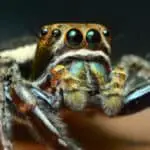Jumping spiders are fascinating creatures that are known for their unique ability to jump and their adorable appearance. They are also popular among pet owners, as they are easy to care for and make great pets. However, one of the challenges of owning a jumping spider is determining its sex or gender. This can be difficult, but there are a few physical characteristics that can help.
Identifying jumping spiders can be tricky, as they come in a variety of shapes and sizes. However, they are generally small, with most species measuring less than an inch in length. They are also known for their large, forward-facing eyes, which give them excellent vision. When it comes to sexing jumping spiders, there are a few key things to look for. One of the most obvious is the size of the spider, as males are typically smaller than females. Another important factor is the coloration and pattern of the spider, which can vary depending on the species.
Key Takeaways
- Identifying jumping spiders can be challenging, but they are generally small with large, forward-facing eyes.
- Sexing jumping spiders can be done by looking at their size, coloration, and physical characteristics such as the shape of their pedipalps.
- Breeding jumping spiders requires careful attention to their environment and feeding habits.

Identifying Jumping Spiders
Jumping spiders are fascinating creatures that are known for their unique physical characteristics and behavior. In this section, I will cover various aspects of identifying jumping spiders, including the species, physical characteristics, behavioral traits, habitat and environment, nutrition and feeding, handling and care, molting process, availability and experience, taxonomy, and how they differ from other spider families.
Species of Jumping Spiders
Jumping spiders belong to the family Salticidae, which is the largest spider family in the world. There are over 5,000 species of jumping spiders, and they can be found on every continent except Antarctica. Some of the most common species of jumping spiders include the Phidippus audax, Phidippus regius, and Salticus scenicus.
Physical Characteristics
Jumping spiders are known for their large eyes, which are located at the front of their head and give them excellent vision. They are also characterized by their compact body shape, short legs, and ability to jump up to 50 times their body length. The size of jumping spiders can vary, but they are generally small, with body lengths ranging from 1/8 inch to 3/4 inch. Male jumping spiders are typically smaller than females, and they are often more varied in color and pattern.
Behavioral Traits
Jumping spiders are diurnal hunters and are known for their excellent vision and ability to stalk prey. They are also known for their mimicry and courtship dance, which are used to attract mates. Jumping spiders are typically found on substrates such as driftwood and branches, and they prefer temperatures that are similar to room temperature.
Habitat and Environment
Jumping spiders can be found in a variety of habitats, including forests, grasslands, and deserts. They are also commonly found in residential areas, such as homes and gardens. Jumping spiders prefer to live in enclosures that are spacious and have plenty of hiding places, such as plants or pieces of bark.
Nutrition and Feeding
Jumping spiders are carnivorous and feed on a variety of prey, including crickets and roaches. They should be fed regularly, and their diet should be supplemented with vitamins and minerals. Jumping spiders should be provided with a water dish, and their enclosure should be kept clean to prevent the growth of bacteria and fungi.
Handling and Care
Jumping spiders are delicate creatures and should be handled with care. They should be kept in a secure enclosure and should not be exposed to direct sunlight or extreme temperatures. Jumping spiders should be kept on a substrate that is easy to clean, such as paper towels or coconut fiber. They should also be provided with a heat mat to maintain a consistent temperature.
Molting Process
Jumping spiders molt regularly, and the process can take anywhere from a few hours to a few days. During the molting process, jumping spiders are vulnerable to predators and should be kept in a secure enclosure. After molting, jumping spiders should be fed a small amount of food to help them recover.
Availability and Experience
Jumping spiders are popular pets and can be found in many pet stores and online retailers. They are relatively easy to care for and are a great choice for beginners. However, they require a delicate touch and should be handled with care.
Taxonomy and New Species
Jumping spiders belong to the family Salticidae, which is the largest spider family in the world. There are over 5,000 species of jumping spiders, and new species are still being discovered. Jumping spiders are closely related to other spider families, such as wolf spiders and Thomisidae.
Jumping Spiders Vs Other Spiders
Jumping spiders are unique in their physical characteristics and behavior. They are known for their excellent vision and ability to jump, which sets them apart from other spider families. Jumping spiders are also diurnal hunters, which makes them different from other spiders that hunt at night.
Sexing Jumping Spiders
Jumping spiders are fascinating creatures that come in a variety of colors and patterns. If you’re a jumping spider owner, it’s essential to know how to sex your spider. In this section, I will guide you through sexing jumping spiders, including male and female jumping spiders, anatomy of reproduction, and sexual characteristics.
Male Jumping Spiders
Male jumping spiders are typically smaller than female jumping spiders and have more ornate markings. They have enlarged chelicerae, which are used to catch prey and defend themselves against predators. Adult male jumping spiders are sexually mature and can reproduce once they reach adulthood. They use their large eyes to detect vibrations from females and perform a courtship dance to attract a mate.
Female Jumping Spiders
Female jumping spiders are typically larger than male jumping spiders and have less ornate markings. They have a genital opening, which is located on the underside of their abdomen, and an epigyne, which is a reproductive organ. Female jumping spiders can lay infertile eggs, even if they have not mated. They are known for their sexual cannibalism, where they may eat their mate after copulation.
Anatomy of Reproduction
Jumping spiders reproduce sexually, and the male spider deposits sperm into the female’s epigyne during mating. The female stores the sperm in a silk sac until she is ready to fertilize her eggs. The fertilized eggs are then laid in a substrate, where they hatch into spiderlings.
Sexual Characteristics
Sexual characteristics in jumping spiders can vary based on the species. Some species, like the Phidippus audax, have more distinct sexual dimorphism, where males and females have different body sizes and ornamentation. Other species, like the Thomisidae, have less obvious sexual dimorphism. Jumping spiders use pheromones, courtship displays, and sexual selection to attract mates and increase their reproductive success.
In conclusion, sexing jumping spiders is essential for breeding and understanding your pet’s behavior. By understanding the anatomy of reproduction and sexual characteristics, you can identify the sex of your spider and provide the best care possible. Remember to handle your spider with care and provide a suitable enclosure with proper nutrition, temperature, and cleaning.
Breeding Jumping Spiders
Breeding jumping spiders can be a fascinating and rewarding experience for spider enthusiasts. However, it is important to understand the mating behavior and reproductive process of these spiders to ensure successful breeding. In this section, I will cover the courtship and mating behavior of jumping spiders, the process of sperm transfer, egg laying and care, and the growth of spiderlings.
Courtship and Mating
Jumping spiders have a unique courtship behavior that involves a complex dance performed by the male spider to attract and impress the female. The male spider will wave his front legs and vibrate his body to create a rhythmic dance that is specific to the species. The female spider will respond to the male’s courtship behavior by either accepting or rejecting him as a mate.
Once the male has successfully courted the female, they will engage in copulation. During copulation, the male will transfer his sperm to the female using his pedipalps. The process of sperm transfer is crucial for successful breeding and can take several minutes to complete.
Sperm Transfer
Before mating, the male spider will create a sperm web where he will deposit his sperm. The sperm web is made of silk and is used to transfer the sperm to the female during copulation. The male will then use his pedipalps to transfer the sperm from the sperm web to the female’s reproductive system.
Egg Laying and Care
After successful mating, the female spider will lay her eggs in a silk sac that she creates. The silk sac is usually placed in a safe and protected area, such as under a leaf or in a crevice. The female will then guard the silk sac and eggs until they hatch.
During this time, it is important to provide the female with a suitable environment that is free from disturbances. The ideal temperature and humidity levels for breeding jumping spiders can vary depending on the species, so it is important to research the specific requirements for your spider.
Spiderlings and Growth
Once the eggs hatch, the spiderlings will emerge from the silk sac and begin their growth process. Spiderlings require a suitable environment that is humid and warm to ensure proper growth and development. They will also need a steady supply of food, such as fruit flies or small insects.
As spiderlings grow, they will molt several times before reaching maturity. Molting is the process of shedding their exoskeleton to allow for growth. During this time, it is important to provide the spiderlings with a suitable environment that is free from disturbances and provides ample space for growth.
Breeding jumping spiders can be a rewarding experience for spider enthusiasts. By understanding the mating behavior and reproductive process of these spiders, you can ensure successful breeding and the growth of healthy spiderlings.
Frequently Asked Questions
How can you identify the gender of a jumping spider?
The easiest way to identify the gender of a jumping spider is by examining its chelicerae. In Phidippus regius, the fangs of males turn green-blue, while those of females turn pink-pink. Another way to determine gender is by examining the epigyne, a small, hard structure on the underside of the abdomen that stores sperm from the male spider.
What are the physical differences between male and female regal jumping spiders?
Male regal jumping spiders tend to be smaller and more slender than females. They also have more prominent pedipalps, which are used during mating. Females, on the other hand, are larger and have a more rounded abdomen.
Is there a difference in personality between male and female jumping spiders?
There is no scientific evidence to suggest that there is a difference in personality between male and female jumping spiders. However, individuals of the same species may exhibit different behaviors based on their environment and experiences.
Can you determine the gender of a jumping spider by examining its pedipalps?
While male jumping spiders have more prominent pedipalps than females, they are not the only way to determine gender. Examining the chelicerae or epigyne is a more reliable method.
What are the physical characteristics of a female bold jumping spider?
Female bold jumping spiders are typically larger and more robust than males. They also have a distinctive black and white pattern on their abdomen.
Do female jumping spiders tend to be larger than males?
In many species of jumping spiders, females are larger than males. However, there are exceptions to this rule, and size differences can vary depending on the species.








